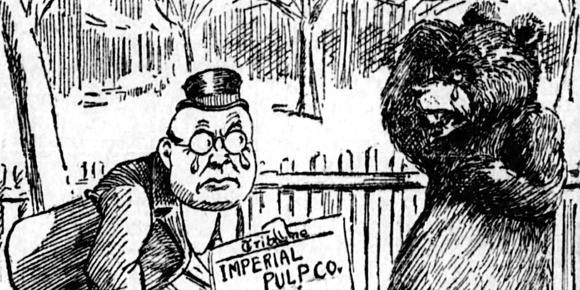by Bruce Cherney (part 3 of 3)
It was asserted in a satirical May 1, 1907, Winnipeg Tribune article that the death of Chad’s Bear would be felt in political circles to the point “that there were persistent rumours of a resignation of one of the cabinet officers (probably Attorney-General Colin Campbell, who the newspaper took such delight in poking fun at), an occurrence so unheard of that the official’s colleagues stood aghast at the prospect of so dangerous a precedent being established and the probable successor to the office to consult a fortune-teller every half hour to find out if so strange a happening could possibly take place.”
Even death didn’t end Chad’s Bear’s career as a public attraction.
Its seven-foot-long pelt was taken to the taxidermy shop of E.W. Darbey to be stuffed and mounted for Homer A. Chadwick, the proprietor of the Deer Lodge Hotel. As a so-called tribute to his pop swilling days, the bear was mounted with a drink bottle placed between his paws.
When the rebuilt Deer Lodge Hotel opened its doors on October 29, 1907 — the original roadside inn was destroyed by fire on February 10 that year — the stuffed bear was on hand to greet dignitaries making speeches during the opening ceremony.
Premier Rodmond Roblin said “he was pleased to see the carcass of the beast who had entertained thousands of children, an equal number of grown-ups, and had helped to make the resort popular with visitors” (Manitoba Free Press, October 30, 1907).
The Tribune on the same day commented: “If the spirit of Chad’s notorious bear was present it must have rejoiced his old heart; as it was he stood in most life-like appearance and characteristic pose at the foot of the main stairway in the rotunda, in the act of draining the contents from a pop-bottle. The sight brought back old memories and added to the charm of the occasion.”
After his death, Chad’s Bear greeted visitors at the foot of the stairway until Deer Lodge until 1916. But that didn’t signal the end of the bear’s days as a public spectacle. The mounted bear was acquired by the Chevrier family as an attraction for their Blue Store on Main Street where it stood in the doorway. When the store was moved to Portage Avenue, the long-deceased bear played the same role.
Eventually, the remains of Chad’s Bear became moth-eaten and tattered because of its daily exposure to sun, rain and snow and had to be replaced.
Actually, several mounted bears would in turn be on public display in the Blue Store doorway over the years.
After the demise of the original Chad’s Bear, the owner of the Deer Lodge Hotel acquired another bear as an attraction for guests.
The Tribune on May 1, 1907, proclaimed with a strong dose of humour, “Le roi est mort; vive le roi,” when it was revealed that Chad’s Bear I was to be replaced with Chad’s Bear II.
Of the coronation, the newspaper stated that “the darkness which precedes the dawn is passing and the advent of a new king is hailed with joy, and editors of society columns are in active competition to get the news of the ceremony which will attend the crowning of the second member of the royal line of Chad’s Bear ...
“However, this may be, the fact remains that Chad’s Bear the First went hence so speedily that the catastrophe found the heir to the throne in a state of entire unpreparedness ...”
The newspaper added that the “unprepared” bear had to be given a crash course on “domestic and political economy, wrestling, boxing and drinking out of the bottle, all of these being deemed de rigeur in the training.
Chad’s Bear II was never as popular as the first bear with the same name. Nor was the second Chad’s Bear fur coat the same colour — it was black, unlike the cinnamon hue of the original Chad’s Bear.
The only thing the two bears had in common was that they were both heralded by local residents as harbingers of the arrival of spring when they awoke from their annual winter slumber.
The reign of Chad’s Bear II ended when the Deer Lodge Hotel was converted into a convalescence home for returning First World War soldiers in 1916.



